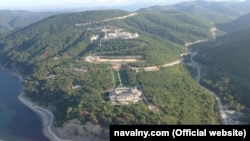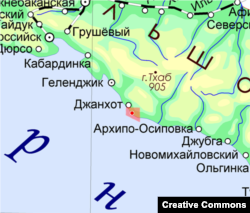A look at the drone that penetrated Russia's "most secure" zone to reveal the scale of the controversial "Putin Palace" property.
Partway through the bombshell video by Aleksei Navalny's Anti-Corruption Foundation (FBK) showcasing "Putin's Palace," some of the more than 100 million viewers noticed an unusual device featured on-screen for a few seconds.
From a small inflatable boat bobbing off the coast of southern Russia, Georgy Alburov, a member of Navalny’s FBK anti-corruption organization, explained that they were about to film "legendary" aerial footage of the palatial property with a drone. The video then cuts to a circling quadcopter with a distinctive orange color scheme.
That drone was made by Autel Robotics, a small American company with a mixed reputation. Some users have described the quadcopters flying "like a brick" and complained of them drifting off course during flight.
Autel's more well-known competitor is DJI, a Chinese-based drone company so far ahead of the competition that in 2020 the company’s products accounted for 77 percent of all drones sold in the United States. No other company had more than a 4 percent market share.
So why was an Autel drone chosen by Navalny’s team?
Alburov remains in prison after being detained on January 21 and other prominent FBK members have either been either jailed or are in hiding. But Navalny says during the video that the filming team "tried four times" and succeeded only once in getting footage. That suggests a no-fly zone above the palace may have prevented more reliable DJI drones from entering the airspace there due to "geofencing."
Geofencing is a kind of phantom "wall" that extends from the ground up and physically prevents drones from entering restricted airspace. Drone pilots approaching a no-fly-zone geofence receive warnings on their controllers before the drone stops and hovers at the edge of the territory.
Since 2015, when a DJI Phantom drone crashed into the lawn of the White House, the company has come under increasing pressure from governments to limit where users of their drones can fly. Meanwhile other, less-prominent drone makers have been able to avoid adding the same stifling software-enforced limitations.
Heather Hall Williams, an American drone photographer, told RFE/RL that she switched from a DJI to an Autel drone after repeated problems with geofencing, saying “it was frustrating to be in compliance with [aviation] regulations, but my drone wouldn't launch because the manufacturer software decided otherwise.”
A statement on Autel’s website notes the company currently enforces geofences "only within countries which require manufacturer restrictions by law," adding that only China legally requires such restrictions. This is in contrast to DJI drones that use software to enforce a vast array of geofencing and other flight restrictions on users.
It is unclear whether GPS “jamming” devices were used to shield the airspace around the highly-secure Black Sea property or how the Autel drone might have overcome such technology.
A drone retailer in Moscow told RFE/RL that Autel drone flights are not currently limited by geofencing in Russia but believes that after the explosive video of "Putin's Palace" that the American-made drone captured, restrictions are likely to be added to the drones in Russia "sometime soon."





